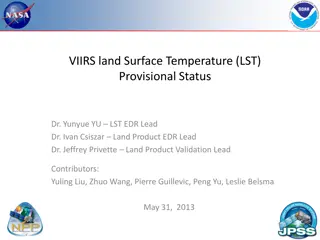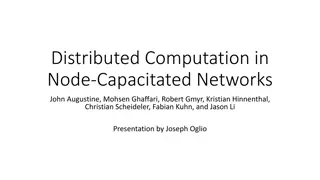Ford-Fulkerson Algorithm for Maximum Flow in Networks
The Ford-Fulkerson algorithm is used to find the maximum flow in a network by iteratively pushing flow along paths and updating residual capacities until no more augmenting paths are found. This algorithm is crucial for solving flow network problems, such as finding min-cuts and max-flow. By modeling residual capacities and ensuring the minimum capacity on a path is greater than zero, the algorithm efficiently determines the maximum flow possible from a source to a sink in a network.
Download Presentation

Please find below an Image/Link to download the presentation.
The content on the website is provided AS IS for your information and personal use only. It may not be sold, licensed, or shared on other websites without obtaining consent from the author. Download presentation by click this link. If you encounter any issues during the download, it is possible that the publisher has removed the file from their server.
E N D
Presentation Transcript
CS 3100 - DSA2 Mark Floryan Min-cut Max-flow, proof of Ford-Fulkerson CLRS 26.1 26.2 1
Module 6! Flow Networks: A new type of problem that is broadly applicable to many areas Solving Flow Networks: Ford-Fulkerson Algorithm Related problems and introduction to reductions: Min-Cut vs. Max-flow Bi-partite matching Circulation networks 2
Flow Network 2 3 3 ? Graph ? = (?,?) Source node ? ? Sink node ? ? Edge Capacities ? ? Positive whole* numbers If ?,? ? then ?,? ? (Note our example here violates this!) ? 3 2 1 2 3 2 3 Max flow intuition: If ? is a faucet, ? is a drain, and ? connects to ? through a network of pipes with given capacities, what is the maximum amount of water which can flow from the faucet to the drain? 3
Flow Network: Antiparallel Edges Easy adjustment to remove antiparallel edges and have equivalent flow graph: add intermediate node 2 2 3 3 3 3 ? 2 ? ? 3 ? 3 2 1 2 3 1 2 3 2 2 2 3 3 (Note: our later examples use graph on the left without this adjustment.) 4
Flow 2/2 1/3 2/3 Assignment of values to edges ? ? = ? E.g. ? units of water going through that pipe Capacity constraint ? ? ?(?) Flow cannot exceed capacity Flow constraint ? ? {?,?}, ?????? ? = ???????(?) ?????? ? = ? ??(?,?) ??????? ? = ? ??(?,?) Water going in must match water coming out Flow of ?: |?| = ??????? ? ??????(?) Net outflow of ? ? 1/1 1/3 ? 2/2 1/2 2/3 1/2 2/3 Flow/Capacity 3 in example above 5
Ford-Fulkerson: Algorithm overview Iterative algorithm: push some flow along some path at each step Model or record the residual capacities how much capacity is left after taking into account how much flow is going through that edge at this time Find a path from s to t such that the minimum residual capacity of an edge on that path is greater than zero Since each value is an integer, it must be 1 or more Update the residual capacities after taking into account this new flow Repeat until no more such paths are found 6
Showing Correctness of Ford-Fulkerson To prove Ford-Fulkerson correct We ll use the idea of a cut in a network flow graph We ll prove properties related to cuts and flows 7
Cuts in Network Flow Graphs Given a flow network, we want to cutedges ? 2 A cut C = (S, T) where: S is a set of vertices (S is a subset of V) T is a set of vertices (T also a subset of V) S intersect T = null set (no shared vertices) S union T = V (all vertices in either S or T) s in S, t in T ? 3 3 ? ? 3 1 2 3 2 3 What do we care about? Well, we care about the edges that go across this cut. Either from node in S to a node in T or vice versa. 8
Two Properties of a Cut Consider a cut that separates ? and ? Let ? ?, ? ?, s.t. ? = ? ? ? 2/2 ? 3 3 ? ? 3 2 3 1/1 2 Capacity of the cut ? = ?,? Sum the capacities of all edges which go from ? to ? This example: 2 + 3 = 5 Net Flow of the cut ? = ?,? Sum of the flows on its edges from S to T minus the sum of the flows on its edges from T to S This example: 2 + 1 1 = 2 1/3 9
Well Show These 3 Things Weak duality property Flow-value lemma Max-flow Min-Cut theorem and how we can then argue Ford-Fulkerson is correct 10
First definition: Weak Duality Let f be any flow and C = (S, T) be any cut Then the value of f <= capacity of C We ll refer to this as the weak duality property Note: We are talking about the capacity of C, not the value of the flow across C (i.e. not the net flow of C) ? ? 2 3 3 ? ? 3 1 2 3 2 3 11
Definition: Flow-value lemma Let f be any flow and C = (S, T) be any cut in G The net flow across (S, T) equals the value of the flow f 2/2 2/3 2/3 ? 0/3 0/1 ? 0/2 1/2 0/3 1/2 1/3 12
Proof: Flow-value lemma Let f be any flow and C = (S, T) be any cut The net flow across (S, T) equals the value of the flow f Proof by induction on the size of T B.C. T = {t} (T is only the sink) Clearly this is true as the flow across the cut is everyone sinking into t, which is the definition of the flow f I.H. Assume true for some cut C = (S, T) I.S. Move one node from S to T Choose a node p to move that has at least one edge to a node in T We know the flow f never changes How does the value of the new cut C = (S , T ) change? It doesn t! Why? See next slide 13
Proof: Flow-value lemma cont. Let f be any flow and C = (S, T) be any cut The net flow across (S, T) equals the value of the flow f Why does C = (S , T ) have the same net flow? Local equilibrium: net flow coming into node p from nodes in S only must equal the flow going out across the cut to nodes in T After node p is moved: everything going across the cut now goes to something in T from T, everything going to or from a node in S now goes across the cut. Thus, by local equilibrium the value of the cut C is equivalent to the value of the cut C Induction done! 14
Max-flow Min-cut Theorem Reminder about weak duality: Let f be any flow and C = (S, T) be any cut Then the value of f <= capacity of C The max flow f <= capacity of any cut C So the best f can be is the capacity of the smallest-capacity cut Can we guarantee that a flow with that value exists? (Yes, in later slides.) The Max-flow Min-cut theorem: the maximum value of an s-t flow is equal to the minimum capacity of an s-t cut In other words, if you look at all the possible cuts in the graph, and find the smallest capacity of those cuts, then that value is the value of the maximum flow for that network. 15
Example: Max-flow/Min-cut Residual Graph ?? 2 Flow Graph ? 2 2/2 2/3 0 2 2/3 1 ? 1 1 0/3 1/1 ? 0 ? ? 1/2 2/2 3 23 0 2/3 0 0 2 2 2/2 0 3/3 3 No Augmenting Paths |?| = 4 Min Capacity cut = 4 Right? Look at other cuts in G. 16
Max-flow Min-cut and Ford-Fulkerson Residual Graph ?? 2 Flow Graph ? 2 2/2 2/3 0 2 1 2/3 1 1 ? ? 0/3 1/1 0 ? ? 3 1/2 2/2 23 0 2/3 0 0 2 2 2/2 0 3/3 3 |?| = 4 No Augmenting Paths Min Capacity cut = 4 Idea: When there are no more augmenting paths, there exists a cut in the graph with cost matching the flow (We re going to use the flow-value lemma here.) 17
Ford-Fulkerson Proof: Outline To show Ford-Fulkerson is correct we will prove: When there are no more augmenting paths in Gf there is a cut in G with capacity equal to the flow f found by Ford-Fulkerson It s not possible for any other flow to have larger value than this f This lets us conclude: the maximum flow through a network matches the minimum-capacity cut Duality When we ve maximized max flow, we ve minimized min cut (and vice- versa), so we can check when we ve found one by finding the other 18
Ford-Fulkerson Proof We ll show the following three statements are equivalent, and together this shows Ford-Fulkerson is correct. For some flow f A) There is no augmenting path in Gf with respect to f B) There exists a cut in G whose capacity equals the value of f C) The flow f is a maximum flow in G Let s prove this equivalence by proving the following three implications: A B B C C A 19
A B: if no augmenting path, cut with capacity f If there is no augmenting path in Gf with respect to f , then there exists a cut in G whose capacity equals the value of f Define ? = nodes reachable from source node ? by positive-weight edges in the residual graph ? = ? ? and ? separates ? , ?(otherwise there s an augmenting path) Let C = (S, T) be the cut that separates S and T Residual Graph ?? 2 Flow Graph ? 2 2/2 0 2/3 2 1 2/3 1 1 ? ? 0/3 1/1 0 ? ? 3 23 1/2 0 2/2 2/3 0 0 2 2 2/2 0 3/3 20 3
A B: if no augmenting path, cut with capacity f Let C = (S, T) be the cut that separates S and T We re trying to show capacity of C is f We can see that Net-Flow(C) = Capacity(C). Why? Because Each of the cut edges in G have forward-flow in Gf of 0 and back-flow in Gf equal to edge s capacity. This means flow in G for each of these edges is max-capacity Residual Graph ?? 2 Flow Graph ? 2 2/2 2/3 0 2 1 2/3 1 1 ? ? 0/3 1/1 0 ? ? 3 1/2 2/2 23 0 2/3 0 0 2 2 2/2 0 3/3 21 3
A B: if no augmenting path, cut with capacity f Let C = (S, T) be the cut that separates S and T We re trying to show capacity of C is f We know Net-Flow(C) = Capacity(C). Why? Because Each of the cut edges in G have forward-flow in Gf of 0 and back-flow in Gf equal to edge s capacity. This means flow in G for each of these edges is max-capacity Flow-value Lemma: The net flow across C equals the value of the flow f Therefore: The capacity across C equals the value of the flow f We ve thus proven: If there is no augmenting path in Gf with respect to f , then there exists a cut in G whose capacity equals the value of f Tell me: how could we identify this cut C = (S, T)? 22
B C: if cut with capacity f, f is max-flow If there exists a cut in G whose capacity equals the value of f , then the flow f is a maximum flow in G Proof by contradiction Let f be a flow larger than f (the capacity of the cut C found by Ford- Fulkerson) Flow-value lemma tells us: f = Net-Flow(C) Given: f = Capacity(C) If f > f , then Net-Flow(C) > Capacity(C) Contradicts weak-duality property: Value of any flow through C <= Capacity(C) 23
These Prove Correctness of Ford- Fulkerson We said: To show Ford-Fulkerson is correct we will prove: When there are no more augmenting paths in Gf there is a cut in G with capacity equal to the flow f found by Ford-Fulkerson It s not possible for any other flow to have larger value than this f A B: If there is no augmenting path in Gf with respect to f , then there exists a cut in G whose capacity equals the value of f B C: If there exists a cut in G whose capacity equals the value of f , then the flow f is a maximum flow in G 24
C A: if f is max-flow, then no augmenting path Just to go full circle , let s show this too! If the flow f is a maximum flow in G, then there is no augmenting path in Gf with respect to f Proof by contradiction Assume f is max-flow but there exists an augmenting path p in Gf Path p can add positive-value flow fp to the overall flow through G So overall flow of f + fp is possible in G Contradiction: we said fis maximum flow that s possible 25
Other Max-flow algorithms Ford-Fulkerson ?(? ? ) Edmonds-Karp ?(???) Push-Relabel (Tarjan) (??2) Faster Push-Relabel (also Tarjan) (?3) 26

















































